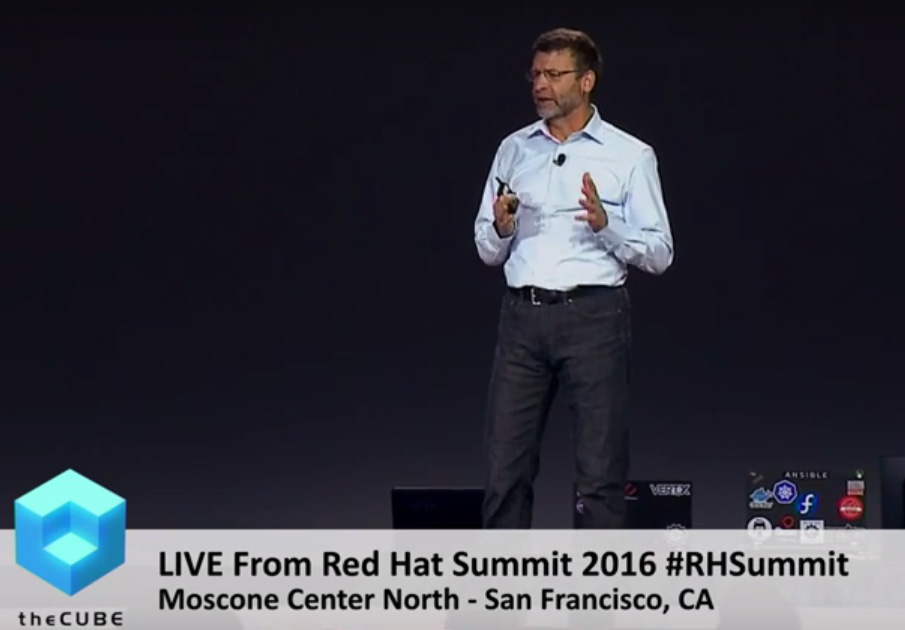 NEWS
NEWS
 NEWS
NEWS
 NEWS
NEWS
As Paul Cormier, EVP of Engineering and president of Products and Technologies at Red Hat, Inc., led the keynote address on Day Two of Red Hat Summit 2016 in San Francisco, he began by looking back over the early days of the summit. Cormier looked back at the vision and the evolution of open source and said he was amazed at what has happened over the past 12 years and at how IT is evolving.
He talked about the phasing of IT’s growth, noting popular catch words the industry uses, such as digital, transformation, mode one or mode two, the path to the hybrid cloud, or cloud-native IT. “But it’s the same market forces that are causing the role of IT to change at such a rapid pace,” said Cormier. He went on to say that he believes that the open-source community is responsible for that change.
According to Cormier, the change is happening in architecture, process and platform, but simultaneously from both an infrastructure and applications perspective all at once. He looked at the infrastructure side and acknowledged that the rapid changes started with Linux, and then Linux in the enterprise.
He pointed to the commoditization of the computing platform with more power and less cost, and he believes the “commodity play” has moved to the open-source world and is the driving force of the innovations happening today.
“Moving from propriety to open, even in the application model as well, it’s all about the application. And that’s the model that is changing right now. We are moving from single footprints to a combination of physical, virtual, and public and private cloud for infrastructure — all at once,” Cormier clarified.
Also stating that storage and networking infrastructures are changing all at once as well, Cormier maintained that they have to be accessible anywhere to support that diverse architecture. He also added that common management and consistency are required and that management has to retool due to the drastic changes in infrastructure. “This is the way to sustain it long term — to have all pieces move and change at once,” he claimed.
Discussing the need for stability in the enterprise, Cormier expressed that companies want to consume the innovative changes, but there is still the need to run the business while the manage the change. He stated there is a need for new tools and infrastructure to support the changes as technology progresses.
Software lifecycles need to be changed, tracked and maintained across this new architecture, and tools are rapidly changing. “We bring architecture, tools and process changes, and integrated usable platforms to our customer base. That’s how we accomplish this at Red Hat,” Cormier asserted. He continued to say integration has to happen together, not in silos.
Cormier believes that the application development for architecture process and platform development should be the same as it is on the infrastructure side. There is a desire to move applications into a monolithic, micro-services architecture.
Cormier feels when making these changes, the technology must be easy to acquire, and again he pointed out that open source and Linux are leading the innovations. He said that application technology must be integrated with the infrastructure into a seamless application development process, and it must be easy to use for the developer. And it has to be easily managed and deploy out into the cloud.
He also stated that we need to support users with new mediums like web, mobile and whatever’s next. We’re moving so fast we don’t know what the next new technology is, he stated.
According to Cormier, customers like Betfair, Amadeus and Target are leading the innovation. He expressed that these companies had real business problems to solve, but they also had to solve a culture problem in IT.
“Culture has been the core of the open-source development model from the beginning. I would also say that it is one of the things that make the open-source development model work,” he stated. Explaining that the culture is important at Red Hat, he said that customers, partners and even competitors also have to move to that culture.
He insists that culture is important to creating unison to unlock technology for the next generation, expressing that open source has become the standard because the problems are too big for one company.
He commented on a survey that revealed 65 percent of companies are contributing to open source and 75 percent of the enterprise runs on open source. Companies who do not embrace this model will not progress, he affirmed. “This is the only model for innovation to progress at such a rapid pace,” he said.
Cormier is certain that the next-generation architecture being built on microservices, the next generation process is DevOps, and the next-generation platform is Open Hybrid Cloud, and they all will change, move and innovate in unison.
Talking about application development in practice, Cormier laid out the strategies of what you need to consider before you even begin writing code. Things like integration technologies, process automation and data services. He walked through stabilizing the entire infrastructure to create, change and deploy into production in a stable environment and reminded us that Red Hat has been focused on developers and their productivity for over 10 years.
Red Hat has also launched Red Hat Open Innovation Labs to help developers move more quickly into mainstream production. Cormier ended his keynote segment by saying the power of open-source development is building the next generation of IT.
Burr Sutter, director of Development Experience at Red Hat, brought a team of developers and engineers on stage to provide a hands-on experience for developers and provide insight into the life of software production.
Watch the video below to see all the action, as well as to hear more about how Red Hat Innovation Labs, the company’s expansion in the container category and its newest Platform as a Service (PaaS) products.
THANK YOU